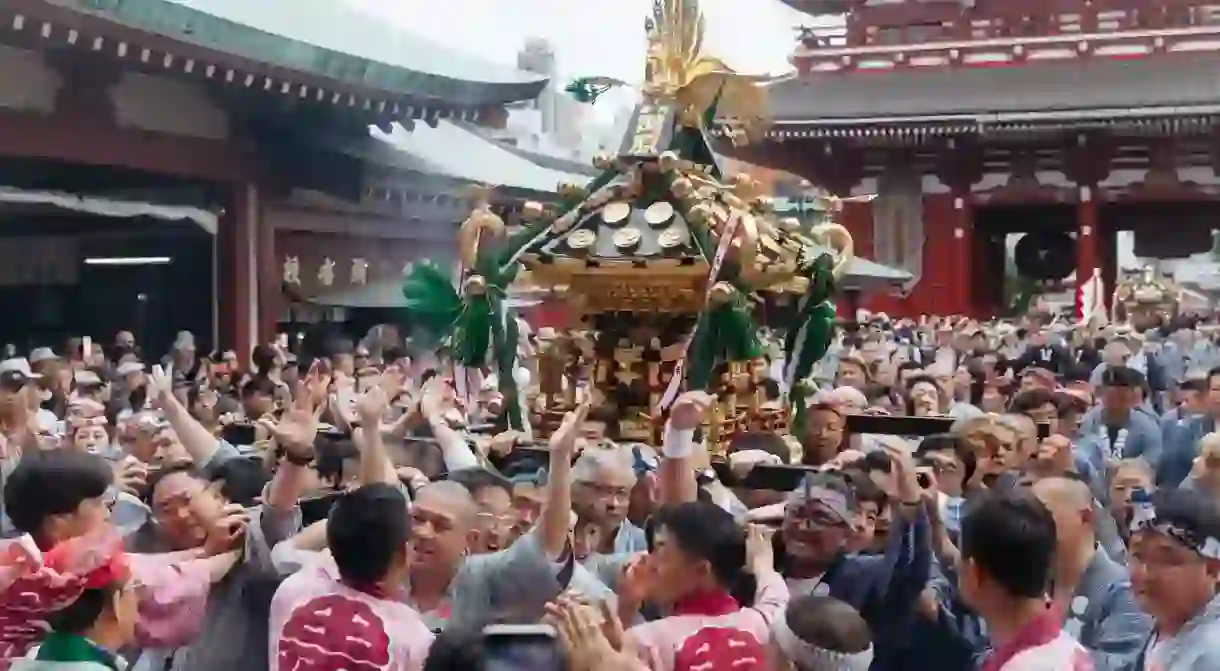A Brief History of Sanja Matsuri, Tokyo's Biggest Spiritual Celebration

The Asakusa district in Tokyo is no stranger to bustling crowds. During three days in May, however, the bustle goes up a notch as millions descend on the area en masse for the city’s biggest religious festival.


The Festival
Sanja Matsuri, which translates as the Three Shrine Festival, is a spectacular affair and a highlight of Tokyo’s annual calendar. It’s widely recognised as the biggest celebration of its type in the city, not to mention one of the most extravagant, as it takes place over an entire weekend and involves hordes of revellers rubbing shoulders while taking in the many sights, sounds, food and beverages, like a sort of Shinto Glastonbury. Nearly two million people usually attend across all three days.

Why It’s Held
The event usually takes place over the third weekend of May, and this year’s celebration began on Friday, May 18. The whole thing is held to honour three men – Hinokuma Takenari, Hajino Nakatomo and Hinokuma Hamanari – whose collective claim to fame is that they co-founded the site which would become the grand Senso-ji temple in Asakusa, the oldest place of worship in the city and itself a symbol of peace and rebirth to the Japanese people (fitting, as it was destroyed by Allied bombing during the Second World War before being rebuilt).


Origins
The three men’s story is as follows: one fateful day in March 628 AD, the Hinokuma brothers were fishing in the Sumida River when they caught something unusual in their net – a statue of the Boddhisatva Kannon (also known as Guan Yin), a Buddhist icon and one of the ascended masters of Eastern spirituality. A wealthy landlord (Nakamoto) caught wind of their discovery and, taking it as an auspicious indicator, approached the pair with a view to converting them to Buddhism.
His efforts paid off, and the three men consecrated the artifact in a modest temple before then devoting their lives to Buddhism. The festival honouring the trio has gone through many changes over hundreds of years, but it solidified, more or less, during Japan’s Edo period, which brought 250 years of solidarity and prosperity to Japan after years of brutal feudalism. The Asakusa shrine itself was built at the behest of shogun Tokogawa Iemitsu, intended as a site to honour the kami – or spirits – of the three men.



The Present Day
In the ensuing years, the shrine has since became a focal point for celebrations at which all are welcome. During the three-day festival, the atmosphere is one of energetic revelry, as the streets surrounding Asakusa come alive with chanting, whistles, flutes and frenetic taiko drumming. Hundreds of nearby shops and stalls sell trinkets and food, and there are even performing geishas.
The grand climax comes on the festival’s third day, when three large mikoshi, or portable shrines, are carried throughout the streets to a rapturous response and frenzied use of smartphone cameras. About 100 smaller shrines are also carried through the streets. Festivities carry on well into the night, as the event has a reputation as one of the biggest knees-ups in the country. If you’re interested in paying a visit, next year’s celebration is scheduled to take place on May 17, 2019.































